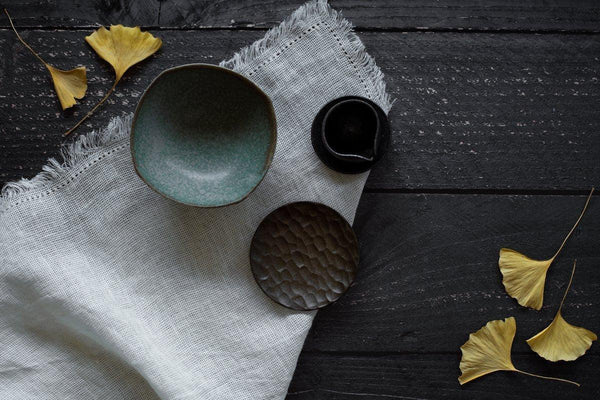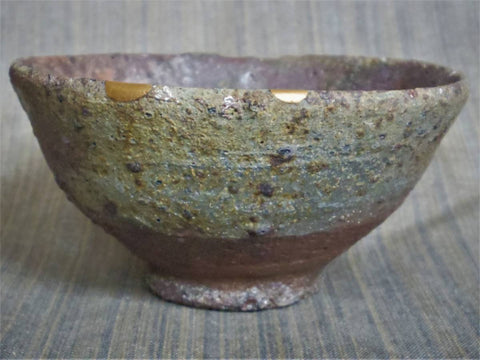
Jump to:
Japan has a rich and expansive culture filled with many famous forms of art. Porcelain and ceramic pottery being some of the most well known Japanese art types. Are you interested in learning about the history of Japanese ceramics or purchasing a piece of Japanese ceramic-ware but don’t know where to start?
With the more than 50 types of ceramic styles in Japan, it can be difficult to know where to focus your attention to. Each style has its own unique characteristics ranging from the material used, to the colors used, whether it’s glazed or not, the temperature at which it’s fired, and so much more. Learning about every single style in one blog post might be more than a bit troublesome, so instead, we’re going to focus on 6 famous ceramic styles in Japan that we think you should know about. Why don’t you add one of these Japanese ceramic towns to your travel itinerary for your next Japan trip?
We’ll cover:
- What makes Japanese Ceramics so special
- Porcelain clay styles of Japanese ceramics
- Soil clay styles of Japanese ceramics
- Japanese ceramics made of both porcelain and clay
What is so special about Japanese Ceramics?

Ceramics is one of the oldest Japanese crafting forms, dating all the way back to the Neolithic period, or the stone age. Since Japanese styles of ceramics date back to between 10,000 to 300 BCE, Japan holds one of the oldest ceramic traditions in the world. As previously mentioned, Japan also carries more than 50 styles of ceramics that are all unique from each other. That means there’s a lot to explore in the Japanese world of ceramics.
In everyday life, Japanese ceramics and pottery carry a lot of importance. They are used in a variety of ways ranging from everyday household use, traditional tea ceremony, being displayed in museums, and more. You can even take pottery lessons for specific pottery styles depending on the town. Ceramic pieces used for plating dishes have the power to completely set the aesthetic of the dish. Clay ceramics used in tea ceremony holds individual importance as well. The bottom-line is that ceramicware does not have an empty meaning in Japanese culture. Creating ceramics is a rich-cultural practice that has been demonstrated over and over again.
Porcelain Clay Ceramicware

Porcelain ceramics have been popular in Japan for many centuries. Many ceramists choose ceramic clay over other types of clay because it is lighter, yet extremely durable at the same time. Porcelain also gives an elegant finish to whatever it is being used for. The practice of using porcelain in ceramics comes from China, so Chinese influence can be seen in Japanese ceramicware that use porcelain. There are many varieties of Japanese ceramics featuring porcelain, but we’ll focus on three different styles in this section. They are Arita-yaki, Kutani-yaki and Hasami-yaki.
Arita-yaki 有田焼

Arita-yaki, or commonly referred to as Imari-yaki is possibly the most well-known style of ceramics in Japan. It was invented in Saga prefecture, in the two towns of Arita and Imari. Arita-yaki and Imari-yaki are used interchangeably, as they refer to the same style of ceramics, but in this post we will be referring to the style as Arita-yaki.
This style of ceramics was crafted in the beginning of the 17th century, around the time when exports from China began to lessen. Arita-yaki is famously known for featuring painted designs in its ceramicware. Arita-yaki always includes cobalt blue, which gives the ceramicware a more oriental feeling, paired with the classy white surface of porcelain. This style of ceramics originally only used cobalt-blue and white, but as time passed, other colors began being incorporated. Other colors used in Arita-yaki include red, gold, yellow, and green. It is often compared to a style called Kutani-yaki, which we will discuss in this post as well.
During the 18th & 19th centuries, or the Edo period, Arita-yaki became much more popular among the Japanese and it started commonly being incorporated into everyday life. It would often be used as tableware. Many people gravitated towards Arita-yaki because with a base of porcelain, it is not too heavy but is thinner and more durable than ceramicware that uses other materials. In more recent times, Arita-yaki is also said to have gained popularity in Europe. These days, many people still love and value Arita-yaki by using it in their daily lives. It is even given as gifts by the imperial household!
Kutani-yaki 九谷焼

Around the beginning of the Edo Period, a style of ceramics known as Kutani-yaki began popping up. Its production began in Kaga, Ishikawa, formerly known as Kaga province. Kutani-yaki is known for being very colorful and easy to recognize. Colors typically used are red, blue, green, purple, and yellow. It also features drawings and paintings that have been smoothly added to the surface of the porcelain. Some consider the Kutani-yaki style of ceramics to be slightly gaudy, because of how bright and colorful it is. However, Kutani-yaki is often compared to Arita-yaki in that they both use similar colors and are both porcelain ceramicware. While Kutani-yaki being too colorful depends on each individual’s opinion, it cannot be denied that this style of ceramics holds its own sense of charm. It should also be noted that Kutani-yaki intentionally mimicked ceramics coming from China during the beginning of the Edo period. During this time, China had decreased its exports into Japan, but the Japanese still wanted to enjoy their ceramics, so Kutani-yaki was created to hold this purpose.
Hasami-yaki 波佐見焼

Another popular style of porcelain ware is known as Hasami-yaki. Hasami-yaki is a ceramic style that originates from Hasami town in Nagasaki Prefecture. It took heavy inspiration from Korean ceramics in the 15th century, and began gaining popularity almost 400 years ago during the Edo period. Interestingly, this style started off as a strictly clay-made pottery, but production later switched to porcelain. The reason for the switch was because porcelain clay became more available during the Edo period. Porcelain was thought to have a luxurious look compared to ceramics made with other kinds of clay.
One of the iconic styles of Hasami-yaki is a white porcelain base with indigo-blue pigmented designs. While there of course many other styles available, people constantly admire Hasami-yaki for its pleasant aesthetics and functionality. It is said that Hasami-yaki has still held its popularity, and it has actually spread throughout Japan and abroad.
Soil clay Ceramicware

Porcelain is not the only material used in Japanese ceramics, soil clay is also a popular choice. It is rustic, and gives a more homemade feeling to whatever it is being used for. It is also much more porous than porcelain, and can be left unglazed before being fired. Soil clay is used in the production of earthenware, stoneware, and pottery, so all of these styles will be classified as clayware. The two most famous styles of clayware in Japan are Shigaraki-yaki and Bizen-yaki.
Shigaraki-yaki 信楽焼

Shigaraki-yaki is a style of clayware that originates in southern Shiga prefecture, in the town of Shigaraki. Shigaraki features one of the oldest pottery centers in Japan, so you can visit there and learn about this style of clayware’s vast history! Another fun fact about Shigaraki-yaki is that the largest number of ceramic tanuki (raccoon in Japanese) are produced using Shigaraki-yaki.
Shigaraki-yaki can be either glazed or unglazed and features simple designs, it is quite rustic compared to porcelain ceramics. A mixture of high quality clays made from soil with coarse textures are mixed together to create a strong clay. The technique of mixing clays is used to give Shigaraki-yaki a simple and imperfect, yet genuine look. Kneading together multiple clays is a technique also often used to make larger pottery vessels. Interestingly the soil used in the clay comes from Lake Biwa (a very large freshwater lake in Shiga) because it is fire-resistant and aids in producing a rustic texture.
Before Shigaraki-yaki pieces are fired, small carvings or markings are imprinted onto the surfaces. Common designs include matsukawa (松川) pine bark, or small flower designs.
After designs or patterns have been imprinted, Shigaraki-yaki pieces are fired in a two step process - first at a low heat and later at a much higher heat. While this is a very effective method for firing clayware, there is a high chance that imperfections may form in the firing process. Instead of trying to hide these imperfections, there are cases where gold detailing, known as kintsugi, is used to cover them up. In fact, the use of kintsugi actually highlights the imperfections and emphasizes the point that no two pieces of Shigaraki-yaki can look exactly the same. The gold detailing also adds an elegant touch to this rustic pottery style. As for the colors of this pottery style, the firing process leaves Shigaraki-yaki pieces with a reddish brown and scarlet color.
Another notable fact about Shigaraki-yaki is that it is often featured in Japanese tea ceremony. They are rustic, but elegant and unique pieces of pottery that add a traditional touch to whatever occasion they are used for.
Bizen-yaki 備前焼

Bizen-yaki is another variety of clayware that originates in Bizen city, Okayama prefecture. It is one of the oldest pottery styles in Japan, dating all the way back to the Nara period (710-794).
Bizen-yaki is not glazed, so it has a much more rustic and simple look compared to other styles of Japanese clayware. It is made of a strong clay that can be fired at high temperatures (1200-1300 degrees celsius), leaving the pottery with a reddish-brown color, distinguishing it as Bizen-yaki
The clay used for Bizen-yaki is called hiyose clay, which is collected around the city of Bizen. As mentioned, Bizen-yaki is not glazed, and that is because it is difficult to spread enamel around the surface of hiyose clay. The clay must also go through a weathering process that can take up to a few years before it can be used. Therefore, it is important to only use high quality clay that can withstand the extremely hot firing process.
Similarly to Shigaraki-yaki, Bizen-yaki is also often used in Japanese tea ceremony because it gives off a “wabi-sabi” or traditional Japanese aesthetic. Due to the high-temperature firing process, Bizen-yaki is also known for being very sturdy.
Pottery made of Porcelain and Soil Clay

Did you know that it is also possible to combine both porcelain and soil clays to create pottery pieces? It is a common practice done, even by Japanese potters. Porcelain and soil clays can be fired at similar temperatures, and pieces that contain both of these materials can come out having a different texture from pieces made solely from porcelain or soil clay. By combining these two materials, pieces created can also have new characteristics that are not found in only porcelain or soil clay pieces. One very famous style that combines porcelain and soil clay is Mino-yaki.
Mino-yaki 美濃焼

Mino-yaki may be one of the most well-known styles of pottery featured in this post. It originates in Gifu, in the cities of Tajimi, Toki, and Kani, which are all located in the southeastern part of the prefecture. Crafting began in the 5th century, when the potter’s wheel and anagama (ancient pottery kiln) were introduced to Japan from Korea. Mino-yaki started off being produced just from porcelain clay, but as much time passed, the idea of glazing pottery with white glaze began to sound appealing, and was produced.
After the mid-to-late 1800s, potters could add color to Mino-yaki by using imported coloring pigments. Other techniques such as transfer printing and screen printing of designs were eventually introduced. Therefore, pottery with a clay base but porcelain feeling that could be colorful and have designs had been created, and it became a huge hit in Japan. In fact, it is said that even today Mino-yaki is the most-produced type of pottery in Japan, accounting for over 60% of traditional Japanese tableware.
Mino-yaki has not only gained popularity among Japanese, but it has also become famous globally. It has a rustic charm because of its soil clay base, yet it has the ability to elevate whatever is being served in it. Many famous chefs see the charming qualities in Mino-yaki and opt to use it for their own plating purposes.
Which Style Should You Choose?
As you can see, the world of Japanese ceramics is very diverse. Each individual type of ceramics has their own unique qualities. There are different materials that can be used, the firing process can differ, and so many more factors go into deciding each Japanese ceramicware style. Each of these 6 styles of ceramics are local to their perspective towns, and have informational centers and museums that you can visit. If you want to learn more about Japanese ceramics, you should definitely consider visiting a Japanese pottery town.


0 comments